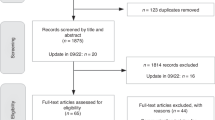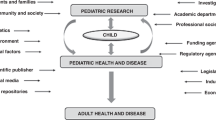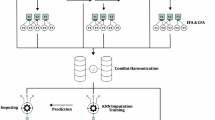Abstract
Meaningful child participation in medical research is seen as important. In order to facilitate further development of participatory research, we performed a systematic literature study to describe and assess the available knowledge on participatory methods in pediatric research. A search was executed in five databases: PubMed, CINAHL, PsycINFO, Scopus, and Cochrane. After careful screening of relevant papers, finally 24 documents were included in our analysis. Literature on participatory methods in pediatric research appears generally to be descriptive, whereby high-quality evidence is lacking. Overall, five groups of participatory methods for children could be distinguished: observational, verbal, written, visual, and active methods. The choice for one of these methods should be based on the child’s age, on social and demographic characteristics, and on the research objectives. To date, these methods are still solely used for obtaining data, yet they are suitable for conducting meaningful participation. This may result in a successful partnership between children and researchers. Researchers conducting participatory research with children can use this systematic review in order to weigh the current knowledge about the participatory methods presented.
Similar content being viewed by others
Log in or create a free account to read this content
Gain free access to this article, as well as selected content from this journal and more on nature.com
or
References
United Nation Convention on the Rights of the Child, article 12, 20-11-1989. (http://www.ohchr.org/en/professionalinterest/pages/crc.aspx.)
Whiting L. Involving children in research. Paediatr Nurs 2009;21:32–6.
Dockett S, Einarsdottir J, Perry B. Research with children: ethical tensions. J Early Child Res 2009;7:283–98.
National Institute of Health Research. INVOLVE’s definitions. What is public involvement in research? 2015. (http://www.invo.org.uk/find-out-more/what-is-public-involvement-in-research-2/.)
Brett J, Staniszewska S, Mockford C, et al. Mapping the impact of patient and public involvement on health and social care research: a systematic review. Health Expect 2014;17:637–50.
Bird D, Culley L, Lakhanpaul M. Why collaborate with children in health research: an analysis of the risks and benefits of collaboration with children. Arch Dis Child Educ Pract Ed 2013;98:42–8.
Moher D, Liberati A, Tetzlaff J, Altman DG ; PRISMA Group. Preferred reporting items for systematic reviews and meta-analyses: the PRISMA statement. Int J Surg 2010;8:336–41.
Gallacher LA, Gallagher M. Methodological immaturity in childhood research?: thinking through “participatory methods”. Childhood 2008;15:499–516.
Smith R, Monaghan M, Broad B. Involving young people as co-researchers: facing up to the methodological issues. Qual Soc Work 2002;1:191–207.
Gilchrist F, Rodd HD, Deery C, Marshman Z. Involving children in research, audit and service evaluation. Br Dent J 2013;214:577–82.
Clavering EK, McLaughlin J. Children’s participation in health research: from objects to agents? Child Care Health Dev 2010;36:603–11.
Bailey S, Boddy K, Briscoe S, Morris C. Involving disabled children and young people as partners in research: a systematic review. Child Care Health Dev 2015;41:505–14.
Dockett S, Einarsdottir J, Perry B. Young children’s decisions about research participation: opting out. Int J Early Years Educ 2012;20:244–56.
Shaw C, Brady LM, Davey C. Guidelines for Research With Children and Young People. London: NCB Research Centre, National Children’s Bureau, 2011:1–63.
Boyden J, Ennew J. Children in Focus – A Manual for Participatory Research With Children. 1st edn. Stockholm, Sweden: Save the Children Sweden, 1997:1–191.
Gibson F, Aldiss S, Horstman M, Kumpunen S, Richardson A. Children and young people’s experiences of cancer care: a qualitative research study using participatory methods. Int J Nurs Stud 2010;47:1397–407.
Veinot TC, Flicker SE, Skinner HA, et al. “Supposed to make you better but it doesn’t really”: HIV-positive youths’ perceptions of HIV treatment. J Adolesc Health 2006;38:261–7.
Morris C, Liabo K, Wright P, Fitzpatrick R. Development of the Oxford ankle foot questionnaire: finding out how children are affected by foot and ankle problems. Child Care Health Dev 2007;33:559–68.
Milnes LJ, McGowan L, Campbell M, Callery P. Developing an intervention to promote young people’s participation in asthma review consultations with practice nurses. J Adv Nurs 2013;69:91–101.
Stinson JN, Sung L, Gupta A, et al. Disease self-management needs of adolescents with cancer: perspectives of adolescents with cancer and their parents and healthcare providers. J Cancer Surviv 2012;6:278–86.
Clarke S. Informing pre-registration nurse education: a proposal outline on the value, methods and ethical considerations of involving children in doctoral research. Issues Compr Pediatr Nurs 2014;37:265–81.
Horstman M, Aldiss S, Richardson A, Gibson F. Methodological issues when using the draw and write technique with children aged 6 to 12 years. Qual Health Res 2008;18:1001–11.
Bradding A, Horstman M. Using the write and draw technique with children. Eur J Oncol Nurs 1999;3:170–75.
Rich M, Lamola S, Amory C, Schneider L. Asthma in life context: video intervention/prevention assessment (VIA). Pediatrics 2000;105:469–77.
Buchbinder MH, Detzer MJ, Welsch RL, Christiano AS, Patashnick JL, Rich M. Assessing adolescents with insulin-dependent diabetes mellitus: a multiple perspective pilot study using visual illness narratives and interviews. J Adolesc Health 2005;36:71.e9–13.
Watson D, Abbott D, Townsley R. Listen to me, too! Lessons from involving children with complex healthcare needs in research about multi-agency services. Child Care Health Dev 2007;33:90–5.
Malaguzzi, L. For an education based on relationships. Young Child 1993;11:9–13.
Clark A. Ways of seeing: using the Mosaic approach to listen to young children’s perspectives. In: Clark A, Kjorholt AT, Moss P, eds. Beyond Listening: Children’s Perspectives on Early Childhood Services. 1st edn. Bristol, England: Policy Press, 2005:29–49.
Gibson F. Conducting focus groups with children and young people: strategies for success. J Res Nurs 2007;12:473–83.
Staniszewska S, Brett J, Mockford C, Barber R. The GRIPP checklist: strengthening the quality of patient and public involvement reporting in research. Int J Technol Assess Health Care 2011;27:391–9.
Acknowledgements
The authors thank Marijke Kars for her valuable comments on an earlier version of the manuscript.
Author information
Authors and Affiliations
Corresponding author
PowerPoint slides
Rights and permissions
About this article
Cite this article
Haijes, H., van Thiel, G. Participatory methods in pediatric participatory research: a systematic review. Pediatr Res 79, 676–683 (2016). https://doi.org/10.1038/pr.2015.279
Received:
Accepted:
Published:
Issue date:
DOI: https://doi.org/10.1038/pr.2015.279
This article is cited by
-
Key Insights into Developing Qualitative Concept Elicitation Work for Outcome Measures with Children and Young People
The Patient - Patient-Centered Outcomes Research (2024)
-
Characterizing Canadian funded partnered health research projects between 2011 and 2019: a retrospective analysis
Health Research Policy and Systems (2023)
-
Embedding research codesign knowledge and practice: Learnings from researchers in a new research institute in Australia
Research Involvement and Engagement (2022)
-
Research co-design in health: a rapid overview of reviews
Health Research Policy and Systems (2020)
-
A review of reviews on principles, strategies, outcomes and impacts of research partnerships approaches: a first step in synthesising the research partnership literature
Health Research Policy and Systems (2020)



